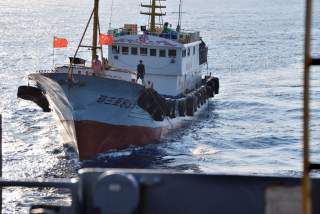Shining a Spotlight: Revealing China’s Maritime Militia to Deter its Use
How China’s maritime militia threatens U.S. and allied interests—and how to counter it.
To support these efforts, the author offers the following memorandum, which he recommends be issued with U.S. government authority.
Fact Sheet: The People’s Armed Forces Maritime Militia (PAFMM)
As the National Security Strategy of the United States of America 2017 emphasizes, China is engaged in continuous competition with America—neither fully “at peace” nor “at war.” Per this national guidance, we will raise our competitive game to meet that challenge, in part by addressing the potential risks to U.S. interests and values posed by all three Chinese sea forces: the Navy, Coast Guard, and Maritime Militia. In terms of ship numbers, each is the largest of its type in the world.
While virtually unique and publicly obscure, China’s Maritime Militia is known clearly to the U.S. government, which monitors it closely. A component of the People’s Armed Forces, it operates under a direct military chain of command to conduct state-sponsored activities. The PAFMM is locally supported, but answers to the very top of China’s military bureaucracy: Commander-in-Chief Xi Jinping himself.
China employs the PAFMM in gray zone operations, or “low-intensity maritime rights protection struggles,” at a level designed to frustrate effective response by the other parties involved. China has used it to advance its disputed sovereignty claims in international sea incidents throughout the South and East China Seas. This undermines vital American interests in maintaining the regional status quo, including the rules and norms on which peace and prosperity depend.
PAFMM units have participated in manifold maritime incidents in the South and East China Seas. Publicly-documented examples include China’s 1974 seizure of the Western Paracel Islands from Vietnam; 1978 swarming into the Senkaku Islands’ territorial sea; involvement in the occupation and development of Mischief Reef resulting in a 1995 incident with the Philippines; harassment of various Vietnamese government/survey vessels, including the Bin Minh and Viking; harassment of USNS Impeccable (2009) and Howard O. Lorenzen (2014); participation in the 2012 seizure of Scarborough Reef from the Philippines and 2014 blockade of Second Thomas Shoal; 2014 repulsion of Vietnamese vessels from disputed waters surrounding CNOOC’s HYSY-981 oil rig; large surge of ships near the Senkakus in 2016; and layered “cabbage-style” envelopment of the Philippines-claimed Sandy Cay shoal near Thitu Island, where China has sustained a presence of at least two PAFMM vessels since August 2017.
The elite units engaged in these incidents incorporate marine industry workers (e.g., fishermen) directly into China’s armed forces. While retaining day jobs, they are organized and trained in the PAFMM and often by China’s Navy, and activated on demand. Since 2015, starting in Sansha City in the Paracels, China has been developing more professionalized, militarized, well-paid full-time units including military recruits, crewing 84 purpose-built vessels with mast-mounted water cannons for spraying and reinforced steel hulls for ramming. Lacking fishing responsibilities, personnel train for peacetime and wartime contingencies, including with light arms, and deploy regularly to disputed South China Sea features even during fishing moratoriums.
There is no plausible deniability: the PAFMM is a state-organized, -developed, and -controlled force operating under a direct military chain of command to conduct Chinese state-sponsored activities. From now on, the United States expects all three Chinese sea forces—including the PAFMM—to abide at all times by the same internationally-recognized standards of law, seamanship, and communications to which U.S. maritime forces adhere; including the International Collision Regulations (COLREGS) and other international regulations governing allowable conduct by ships at sea.
Bottom line: Henceforth, the United States will not tolerate any attempt by the PAFMM to interfere with or compromise the safety, operations, or mission accomplishment of any U.S. government vessel.
Dr. Andrew S. Erickson is a professor of strategy in the U.S. Naval War College (NWC)’s China Maritime Studies Institute (CMSI) and an Associate in Research at Harvard University’s John King Fairbank Center for Chinese Studies. Since 2014, he and his colleague Conor M. Kennedy have been conducting and publishing in-depth research on the People’s Armed Forces Maritime Militia (PAFMM) and briefing key U.S. and allied decision-makers on the subject. In 2017 Erickson received NWC’s inaugural Civilian Faculty Research Excellence Award, in part for his pioneering contributions in this area. You can follow him on Twitter: @AndrewSErickson.
Image: Wikimedia

